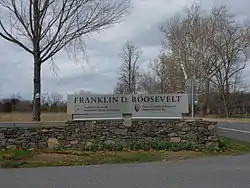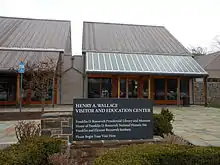| Franklin D. Roosevelt Presidential Library | |
|---|---|
 | |
 Entrance To Franklin D. Roosevelt National Historic Site | |
 | |
| General information | |
| Location | Hyde Park, New York, United States |
| Coordinates | 41°46′07″N 73°56′03″W / 41.768680°N 73.934115°W |
| Named for | Franklin Delano Roosevelt |
| Construction started | 1939 |
| Completed | 1940 |
| Inaugurated | Dedicated on 30 June 1941 |
| Cost | $376,000 |
| Management | National Archives and Records Administration |
| Technical details | |
| Size | 16 acres (6.5 ha) |
| Website | |
| fdrlibrary.org | |
The Franklin D. Roosevelt Presidential Library and Museum is a presidential library in Hyde Park, New York. Located on the grounds of Springwood, the Roosevelt family estate, it holds the records of Franklin Delano Roosevelt, the 32nd president of the United States (1933–1945). The library was built under the President's personal direction in 1939–1940, and dedicated on June 30, 1941. It is the first presidential library in the United States and one of the thirteen presidential libraries under the auspices of the National Archives and Records Administration.
History
Roosevelt was both an avid collector of memorabilia and amateur historian. As a then two-term president who had presided over a sweeping and dramatic phase of the nation’s history during the Great Depression, he recognized the need for a facility to house the vast quantity of historical papers, books, and memorabilia he had accumulated during a lifetime of public service and private collecting.
The library he subsequently commissioned was built by Philadelphia contractor John McShain, on 16 acres (6.5 ha) of land donated by Roosevelt and his mother, Sara.
Margaret Suckley, who acted as Roosevelt's personal archivist during his life, was involved in the establishment of the library and served as its archivist for its first two decades.[1]
Setting a precedent
Prior to Roosevelt's Presidency, the final disposition of Presidential papers was left to chance. Although a valued part of the nation's heritage, the papers of chief executives were private property which they took with them upon leaving office. Some were sold or destroyed, while others remained with families but inaccessible to scholars for long periods of time.[2] Ultimately some collections found their way into the Library of Congress and private repositories.
Franklin D. Roosevelt changed this pattern, by becoming the first president to make his papers available to the public by donating them intact to the government.[2] These covered both all his public service, as New York state senator (1911–13), assistant secretary of the Navy (1913–20), governor of New York (1929–32), and President of the United States (1933–45), and his private collections of papers, books, and memorabilia on the history of the U.S. Navy and Dutchess County, New York.
Location and buildings

The Library sits on the grounds of the Roosevelt family’s Hyde Park estate. It is built of Hudson Valley fieldstone in the style reminiscent of the local Dutch colonial architecture which he favored. A sketch made by President Roosevelt dated April 12, 1937, shows the proposed building placed very close to the site ultimately chosen, and a ground plan roughly approximating that of the main block today.
The building was designed by principal architect Louis A. Simon and consulting architect Henry J. Toombs based on his sketches by Roosevelt himself[3] It was built with privately donated funds, at a cost of $376,000, and turned over to the federal government on July 4, 1940, to be operated by the National Archives.
Said Robert D.W. Connor, the first Archivist of the United States, of the President making his papers openly available to scholars, "Franklin D. Roosevelt is the nation's answer to the historian's prayer."
The facility was already overcrowded when completed in 1940, because Roosevelt did not expect to serve as president for more than two terms. A 1950 estimate stated that the library contained 50 million items, including 16,000 books, 15,000 photographs, 275,000 feet of movie film, and 300 sound recordings.[2]
The library underwent a full-scale renovation in the 21st century, its first, reopening on June 30, 2013. Funded by a combination of public support and private donations, the multi-million dollar renovation included expanded exhibit space, HVAC updates, and research room improvements. Members of the Roosevelt family and the historian Geoffrey Ward spoke at a rededication ceremony that day.[4][5]
Other archives
In early planning for the library the President expressed the hope that Eleanor Roosevelt's papers would eventually find a place here. In 1942 President Roosevelt made a rough sketch for wings to be added on to the north and south sides of the building should additional space be needed for her papers. At the time of her death in 1962 Mrs. Roosevelt's papers totaled three million pages.
During her tenure at the library (1961–1969), Elizabeth B. Drewry raised funds for the wings to house Eleanor Roosevelt's papers. Construction was completed in 1972.[6]
The library contains the donated papers of others associated with Roosevelt, such as Henry Morgenthau Jr.'s diary of 840 volumes.[2]
Presidential Libraries Act

Using Roosevelt's actions as a precedent, Congress passed the Presidential Libraries Act in 1955. It regularized the procedures for privately built and federally maintained libraries to preserve the papers of future presidents; all of the presidents from Herbert Hoover to George W. Bush have a presidential center overseen by the National Archives.
Official presidential papers became public property as a result of the Presidential Records Act of 1978, backed by legislation limiting the size and financing of presidential museums.
Museum

Roosevelt hoped the library would become an important research center and attract visitors to the museum. The museum section of the building opened June 30, 1941. However, the onset of World War II changed Roosevelt's plans, and the official opening of the library as a research facility was deferred as the president served a third term and then was elected to a fourth term in 1944. He visited the library often during the war to sort and classify his records and memorabilia; and from his study in the library he delivered several of his famous War-era radio speeches or "fireside chats".
President Roosevelt paid his last visit to Hyde Park in March 1945 and died on April 12 at Warm Springs, Georgia, at the age of sixty-three.
See also
References
- ↑ "Wilderstein Mansion, Rhinebeck New York". Retrieved 7 August 2016.
- 1 2 3 4 Gunther, John (1950). Roosevelt in Retrospect. Harper & Brothers. pp. 99–100, 102–103.
- ↑ Michael Zipp, "Architectural Chronology," Franklin D. Roosevelt Presidential Library and Museum, no date. Accessed February 4, 2023.
- ↑ "Rededication Press Release".
- ↑ "Franklin D. Roosevelt Presidential Library and Museum Rededication | C-SPAN.org". www.c-span.org. Retrieved 2020-08-03.
- ↑ Errickson, Kaitlin (2016). "Dr. Elizabeth B. Drewry a Leading Lady". Pieces of History. Retrieved 8 August 2016.
External links
- Franklin D. Roosevelt Presidential Library
- Roosevelt and His Library, part 1
- Roosevelt and His Library, part 2
- FDR, His Library, and the National Archives
- "Life Portrait of Franklin D. Roosevelt", from C-SPAN's American Presidents: Life Portraits, broadcast from the home of Franklin D. Roosevelt National Historic Site and the Franklin D. Roosevelt Presidential Library and Museum, October 11, 1999